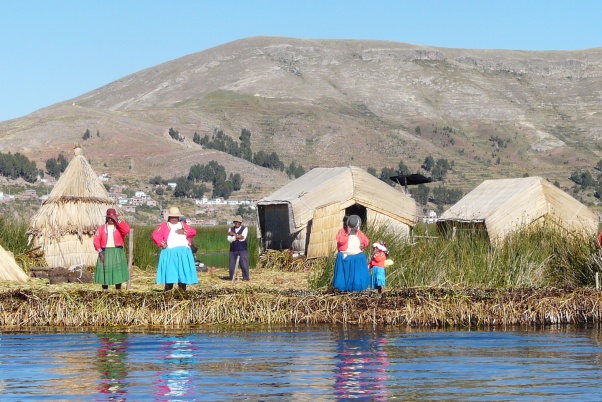Life on the floating Uros Islands

Lake Titicaca in Peru lies 3,800m above sea level. It is also home to entire communities which make their home out of hollow Totora reeds. We chat with our local expert guide for insights into the lives of these fascinating people and their unique way of life.
Can you give us brief history about this community?
According to a genetic study by the Genographic Project Consortium the Uros
settled in Lake Titicaca approximately 3,700 years ago. Citizens of Uros are
known as Qhas Qoot Suni which means “People of water or lake”. When other
groups such as Tiwanaku, Qollas, the Incas and Spaniards invaded, the Uros
were pushed to live on floating islands or small villages near the lake.
How big is the Uros community?
The Centro Poblado Menor de los Uros – Chulluni is the official name of the
community covers about 30,000 hectares within the National Reserve of Lake
Titicaca. There are close to 2,000 people living on the hundred or so islands with
each island housing about four families.
How is the culture different to other places in Peru?
The Uros Islands offers a unique culture that blends a traditional fishing and
hunting culture with a modern tourism infrastructure.
What is it like to live on the islands?
Life is not easy on the floating islands as the temperature on the lake ranges from -10C overnight to 25C during the daytime. The hollow Totora reeds used to build their houses have several layers. During the day the sun heats the air inside the reeds and they retain the heat and act like a heater to warm up their cold nights. They also wear several layers of clothing and use thick blankets called T’amicho which are a set of three blankets made from old clothes stitched together. They say the cold is just a matter of getting used to as they even walk without shoes!
The islands are floating platforms anchored to the bottom of the lake by
the roots of the Totora reeds. Tied up with logs and ropes, the platforms float
on the water, allowing them to walk on the islands. The platforms are removed
and replaced every six months when they get too dry.
What is a typical day like in the life of a family living on the floating islands?They start their day very early at 5am for a family breakfast. The men then go fishing, collect eggs and cut Totora reeds while the women send the children to school, prepare lunch and cater to visitors. The men return to the island for lunch. In the afternoon the women embroider, make their crafts and prepare dinnerwhile the children do their homework. Dinner is a family affair followed by an early night for all.
Can you tell us about the cuisine of the people living on Lake Titicaca?
They use dry reeds to heat small stones to roast fish. Obviously they must be very
careful not to burn their homes! For breakfast mint or eucalyptus tea is accompanied by bread or toasted wheat. Karachi (fish soup) is then served later in the morning and for lunch and dinner, bird stew with rice or potato flour and fried eggs. A typical dinner would consist of Thimphu, a boiled fish dish with dry potatoes and onions. They have very little fruit or vegetable in their diet.
What do guests find the most surprising about the people living on Lake Titicaca? When guests discover the islands are actually floating and seeing people actually
living on the huge lake. It is always a great joy to see the local people in their
traditional costumes smiling and singing. Although, a hard life, the Uros-Chullini
people are proud of their heritage and cherish the land of their ancestors.
What tips would you give Evergreen guests before they visit?
They should brace themselves to be surprised and astonished with so much
colour, ancient living cultures and magnificent landscapes. They should
also bring sunscreen and the appropriate clothes depending on the season.
You too can visit these fascinating islands and the community in Peru on most tours in Evergreen’s South America program.
Read about all our tours and cruises in the new 2017 South America brochure.
